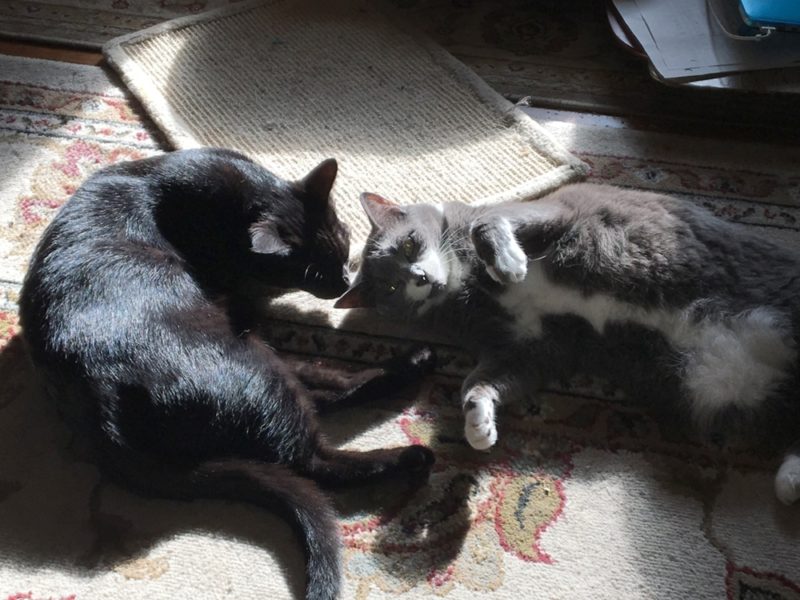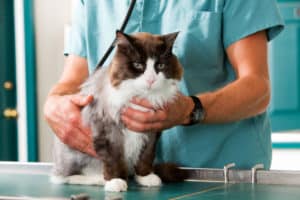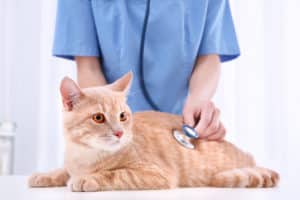Nutrition for senior cats is important. About a week ago, our 12-year-old cat, Periwinkle (pictured above on the right with our youngest cat, Munchkin), had her semiannual checkup and distemper booster. Our vet also verified what we had suspected: Periwinkle is losing weight.
We had blood work done to make sure there wasn’t an underlying cause for the weight loss, and everything came back okay.
Please join my mailing list. I’ll let you know when a new articles are posted.
So, why is our senior cat losing weight?
Generally, the senior years (over 11) are particularly problematic for cats because their sense of smell and taste often diminish at this time which affects their interest in food. The ability to absorb key nutrients and digest fat declines, making eating itself less efficient.
The undesirable result is that more food passes through as waste and less is used for energy, causing a drop in lean muscle mass and body fat that leads to potentially harmful weight loss.
According to Dr. Arnold Plotnick of Manhattan Cat Specialists in New York City:
Dr. Arnold Plotnick has developed a senior wellness program to address the special needs and nutrition for senior cats at his veterinary clinic.
Nutrition for Senior Cats: What Should You Feed Them?
Owners of senior cats can help their aging felines maintain an ideal body weight throughout the senior years by feeding a diet that addresses nutrition for senior cats. Specifically, older cats need higher protein, healthy fats, and enhanced antioxidants.
We’ve always known that protein is essential in a cat’s diet, but it’s also important where that protein comes from.
So, the bottom line here is: read the label. Read the nutrient analysis that shows the percentages of nutrients in your cat’s food, but also read the ingredients list to see where these nutrients are coming from.
In our own case with Periwinkle, our vet recommended that we start feeding her a cat food for senior cats. However, we have 4 other younger cats ranging in age from one to ten. We free-feed our cats by providing dry cat food 24-7.
Several months ago, we had switched all our cats from Blue Wilderness to Iams because our vet had mentioned that the protein content in Blue Wilderness was actually too high, and she recommended Iams for the protein content and the price. What she didn’t mention at that time was that Blue Buffalo has other foods that have a little less protein than Blue Wilderness. After Periwinkle’s blood work came back okay, our vet recommend Blue Buffalo Healthy Aging for her.
The problem for us is that we can’t keep Periwinkle separate from our other cats for feeding purposes. She is social with the other cats and confining her would cause added stress that we believe would be further detrimental to her health.
So, we looked at the nutrient analysis and ingredients of other Blue Buffalo foods and decided to purchase the Blue Buffalo Indoor Health dry cat food and feed it to all of our cats. This food has 4% more crude protein than the Iams and the first ingredient listed on the Blue Buffalo is deboned chicken while Iams lists chicken by-product meal.
We currently have bowls of both foods available to our cats in an attempt to use up the Iams. We could immediately see that the Blue Buffalo pieces are smaller which makes it easier for cats to eat. Fun fact: cats don’t have grinding molars and tend to swallow dry kibble in whole pieces rather than crunch it up.
We also noticed that all our cats prefer the Blue Buffalo. We are suspecting that Periwinkle’s weight loss may have just been because she didn’t really like the Iams and began eating less. We will continue to monitor Periwinkle’s weight. Hopefully the food change will do the trick.
What Should You Do To Help Your Senior Cat?
In addition to providing the proper diet, owners of senior cats should pay close attention to their cats’ activity levels, weight, and eating, grooming and elimination habits and report anything new or different to their veterinarian.
Though many of these changes are a normal part of aging, others may signal a more serious problem. Scheduling veterinary visits at least twice a year is good practice during the senior years as many potentially serious conditions are treatable if caught early.
If you enjoyed this article about why do cats have whiskers, please join my mailing list. I will let you know when I post a new article. Thanks!
Subscribe to Our Email List:
Here are some other cat-related articles you might be interested in.


![Read more about the article Cuddle Clones Review [Grieving a Pet Cat]](https://carolinescats.com/wp-content/uploads/2017/12/tina3-300x240.jpg)

